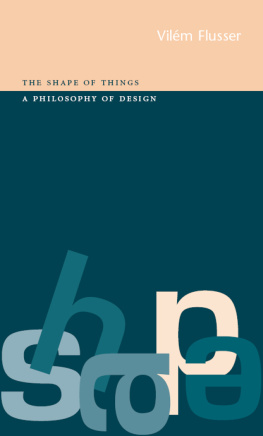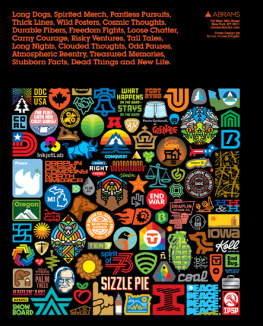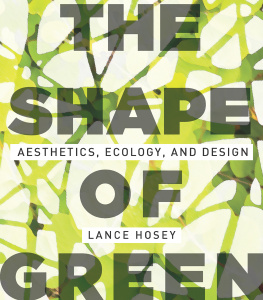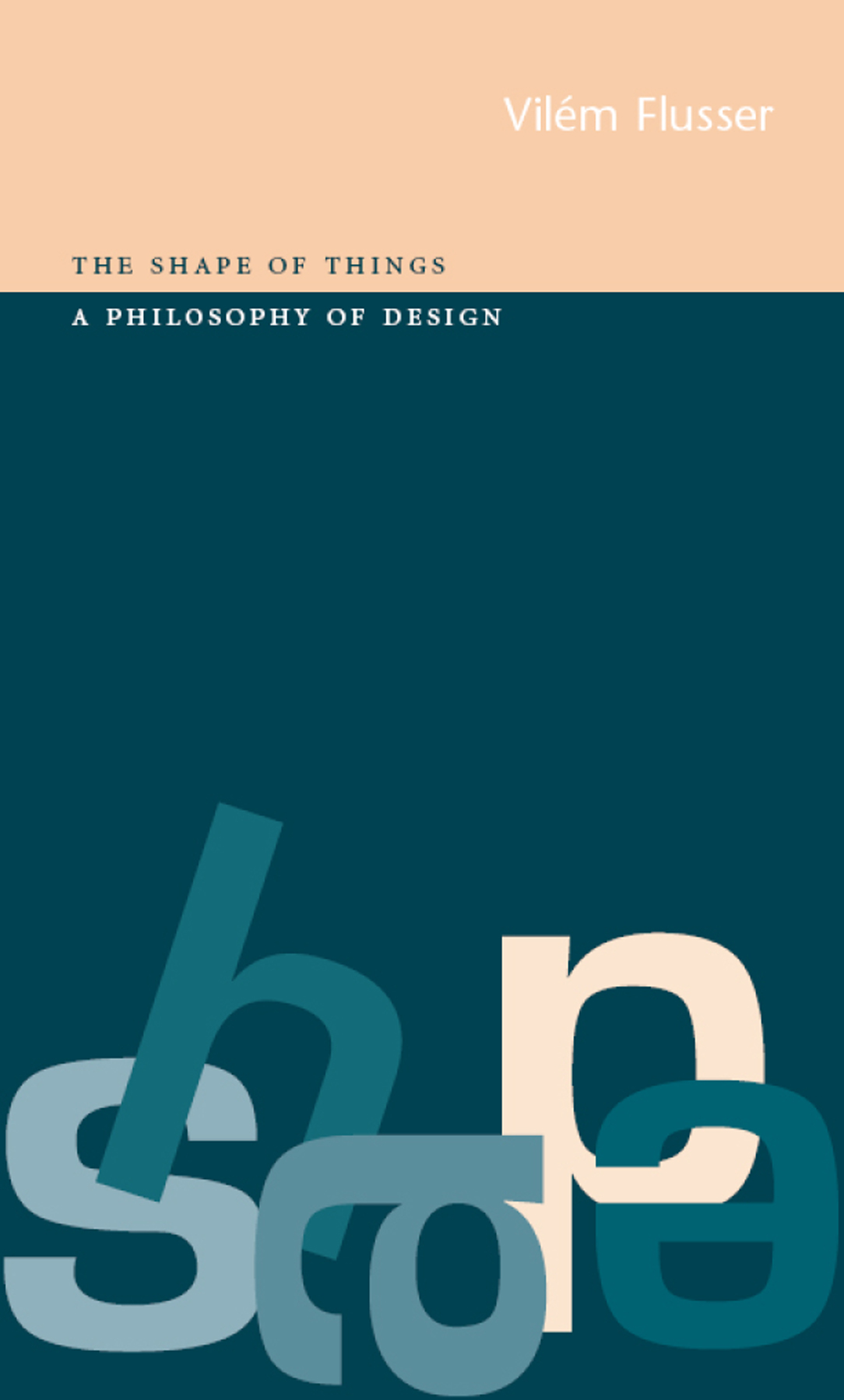The Shape of Things A Philosophy of Design
Vilm Flusser
REAKTION BOOKS
Published by Reaktion Books Ltd
33 Great Sutton Street, London EC1V 0DX, UK
www.reaktionbooks.co.uk
First published in English 1999
English-language translation copyright Reaktion Books 1999
Reprinted 2009, 2010, 2012
Copyright Bollmann Verlag GmbH 1993
The following essays were taken from Vom Stand der Dinge: Vom Wort Design, Form und Material, Der Krieg und der Stand der Dinge, Von Formen und Formeln, Der Blick des Designers, Die Fabrik, Der Hebekl schlgt zurck, Schirm und Zelt, Design: Hindernis zum Abrumen von Hindernissen?, Warum eigentlich klappern die Schreibmaschinen?, Ethik im Industriedesign?, Design als Theologie, Wittgensteins Architektur, Nackte Wnde, Durchlchert wie ein Emmentaler, Schammanen und Maskentnzer, Das Unterseeboot.
Copyridght Carl Hanser Verlag 1993
The following essays were taken from Dinge und Undinge: Das Unding 1
,Das Unding 2, Teppiche, Tpfe, Rdar.
Introduction copyright Martin Pawley 1999
All rights reserved
No part of this publication may be reproduced, stored in a retrieval system or transmitted, in any form or by any means, electronic, mechanical, photocopying, recording or otherwise, without prior permission of the publishers.
Page references in the Photo Acknowledgments and
Index match the printed edition of this book.
Translated by Anthony Mathews
Designed by Ron Costley
Photoset by D R Bungay Associates
Cover design by Philip Lewis
Printed in Great Britain by the MPG Books Group, Bodmin and Kings Lynn
British Library Cataloguing in Publication Data:
Flusser, Vilm, 19201991
The shape of things : a philosophy of design
1. Design Philosophy
I. Tite
770.1
eISBN: 9781780232362
Contents
Introduction
Design is a process that has been variously defined over the years, a process over which many different interest groups have claimed hegemony where the design of spacecraft, aircraft, ships and weapons is concerned, it has always been accepted as a matter of specialist technical expertise. Where grand buildings are under consideration, Art History rules, with Royal Commissions, government departments, local-authority officers and celebrated architects sharing a duty of agreement based on value judgements. In the realm of the consumer, the task of design is constrained by polls, surveys and focus groups, with advertising reinforcing the result and the power of the manufacturer supreme. Where clothes, cars, fashion and furniture are in question, individual genius may appear to be welcome, but distinctions without differences will abound.
For the media philosopher Vilm Flusser, none of the foregoing was of any importance. Flusser understood design in a different way, seeing it as a fit subject for etymological analysis. For this reason, the collection of his essays assembled here not only sheds new light on the importance of design, but also sheds light from an unusual angle. Flussers insights flow not from professional design experience, but from empirical observation. Not from the conventional art-historical critique of form-giving, but from a self-taught grounding in linguistic philosophy that enabled him to deconstruct the design agenda and then reconstruct it in another way. For Flusser, as the reader of these essays will discover, design began not with science, not with the appreciation of fabricated objects, not with the vision of their creators, not even with the fabled first doodle on the back of an envelope. Instead, it began with the meaning of the words and the ensuing discovery of identity.
Just as evolution by natural selection proceeds in the natural world, design by semantic selection makes its discursive, apparently wasteful way in Flussers world towards the perfect reconciliation of needs with resources. Through infinite varieties of form and thought, from Galileo to the Gulf War, it follows in the footsteps of language, sifting and selecting a profusion of alternative objects and viewpoints in the world made by humans. Much as the environment sifts and selects organisms for survival in the natural world, Flusser found meanings and drew them to the surface. Words and the languages in which they are packaged became the means whereby blind, evolutionary-niche-filling design proliferates and cross-fertilises unpredictable patterns of survival.
Flussers world view provides a primer for the number-crunching reality of what might be called real design: a definition that illuminates the vital but random and uncreative roles of invention and technology-transfer even as it diminishes the false claims made for individual genius as well as the distortions encouraged by national chauvinism. For example, in his question-marked essay The Ethics of Industrial Design?, Flusser not only explains apparently arbitrary connections like the link between the cavity magnetron valve and the microwave oven, or that between the Polynesian wooden fishing canoe and the development of polymers and composites; or the relevance of bone china to the production of chocolate, of mathematics to computers, of computers to genealogy, and of genealogy to ecology he also illuminates the crisis of moral responsibility that occurs because of these connections. He posits the state of ultimate irresponsibility that arises when the work of several anonymous designers combines to produce a post-industrial helicopter-pilot complex of human-and-helmet that allows the pilot to aim and fire his guns simply by looking at his target and blinking.
Flussers essays explain and illustrate this inextricable inter-connectedness of technology and responsibility by tracing genetic design chains back into the past. Into old worlds of hardship, self-sacrifice, resourcelessness, survival and ultimate defeat. For he understood that real design is a language whose meaning can best be deciphered under extreme conditions want of knowledge, of resources, of materials, of time want of everything except language and the historically and geographically varied descriptors it provides. Products and systems created in such circumstances, he believed, truly held within themselves the most extreme state of efficiency for the task of species survival. They represented design on the edge of feasibility, where nothing could be done but somehow the possibility of something emerging through human understanding remained until the very end. That is where Flussers vision of the ultimate role of design is to be found: in a crowded and polluted world where people will live in virtual reality most of the time and don special diving suits to visit the real world.
If it is the surprising language and the complete absence of the usual list of famous designer names that gives Vilm Flussers essays on design their freshness and continuing relevance, this is because they are simple without being simplistic. They have a directness that clears the ground. There is no overarching narrative, no fragmentation; every essay is complete. There is no naive faith in science, no hero-worship, no corporate we, none of the underwriting of the myth of individual genius that so often passes for understanding where writers on design are concerned. As well as finding no parade of famous names, the reader will find no contenders put forward for uncritical admiration. Nor, indeed, will he or she be presented with pages of expensive photography (hinting as it invariably does that a deal has been done on the basis of a total suspension of critical faculties).











